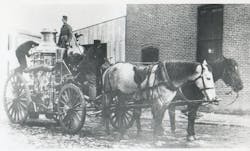PARIS, FRANCE: SEPT. 1, 1911 – Father Abbe Daney, a priest in the Landes region, near Bordeaux, saw local parishioners suffer the devastating loss of their 12-acre pine forest, so this ecclesiastical and would-be scientist and inventor began three years of experiments trying to make a better fire extinguisher. Turning his presbytery into a chemical laboratory, he began rigorous trials, several of which had near-catastrophic outcomes. Finally, he developed an apparatus that used hydraulic pressure to force a fine spray of a liquid salt that turned to gas at 150 degrees Fahrenheit. The extinguisher apparently was effective from a great distance. For his efforts, he was awarded the Cross of the Legion of Honor by the French government. This prestigious award was established by Napoleon Bonaparte in 1802.
JUNEAU, AK: SEPT. 4, 1911 – The Juneau Hotel caught fire and burned furiously, severely taxing responding firemen. Mutual aid was requested to Douglas and the firemen joined forces as the flames extended to the McGrath Building. In all, 11 people lost their lives in the flames and 14 were injured, including two critically.
ANTWERP, BELGIUM: SEPT. 13, 1911 – A fire broke out in a large lumber yard and spread with amazing speed until five vast wood yards were ablaze. Flames spread to a railroad depot and several homes, burning them to the ground. All the firemen in the district were battling the fire and soldiers from a nearby garrison were ordered to aid in firefighting efforts.
RIO DE JANEIRO, BRAZIL: SEPT. 14, 1911 – A huge fire destroyed the Imprensa Nacional (National Printing Works) building and some extremely rare and valuable items stored within the structure. Among the items lost to the flames were valuable archives, catalogs of historic newspapers, many first editions and original copies of important books.
NEW YORK CITY: SEPT. 19, 1911 – During a small cellar fire at 62 West Houston St. in Manhattan, a new firefighting invention was put to the test. Designed by Fireman James D. Halloran of Engine Company 23 (detailed to Engine 20), the device was a garden hose reinforced with spiral wire and stretched from the street with the fire hose. The end of the hose was attached close to the nozzle with smaller hoses branching off to nose cups that were fitted to the face of the nozzle team. As water passed through the attack line, the pressure caused a “Venturi effect,” pulling outside air through the small hose to the firemen inside. This initial test was declared a success as the hose team was able to push in and extinguish the fire while breathing the smoke-free outside air. The commissioner said testing of the device would continue.
NEW YORK CITY: SEPT. 24, 1911 – Blinded by smoke, Battalion Chief William Devlin fell from the roof while operating at a blazing two-story building at 506 Broome St. in Manhattan. The fire originated in the stockroom of Lion Knitting Works, which occupied the second floor. Firefighting efforts were hampered by dense smoke, so the 42-year-old chief led a team to the roof of an adjoining building to chop a hole through the roof of the fire building. Devlin stumbled and fell onto the roof of a small storm shed below. He was removed unconscious and taken to St. Vincent’s Hospital, where he died four days later. Sadly, Devlin was a widower and left behind five children.
About the Author
Paul Hashagen
PAUL HASHAGEN, a Firehouse® contributing editor, is a retired FDNY firefighter who was assigned to Rescue 1 in Manhattan. He is also an ex-chief of the Freeport, NY, Fire Department. Hashagen is the author of FDNY: The Bravest, An Illustrated History 1865-2002, the official history of the New York City Fire Department, and other fire service books.
Connect with Paul
Website: paulhashagen.com
Facebook: Paul Hashagen-author
